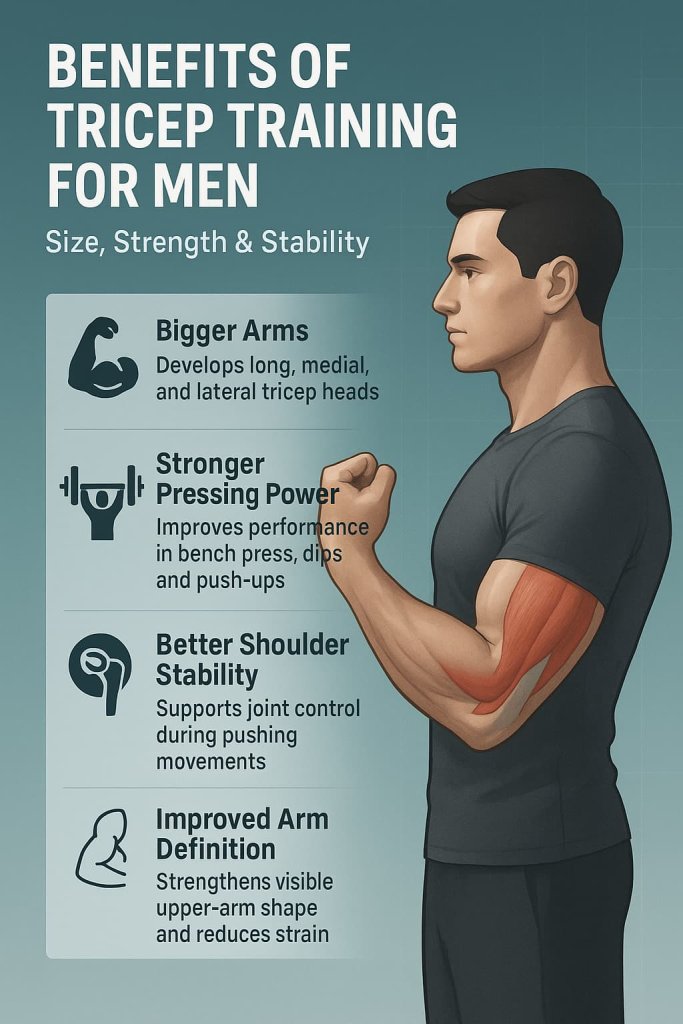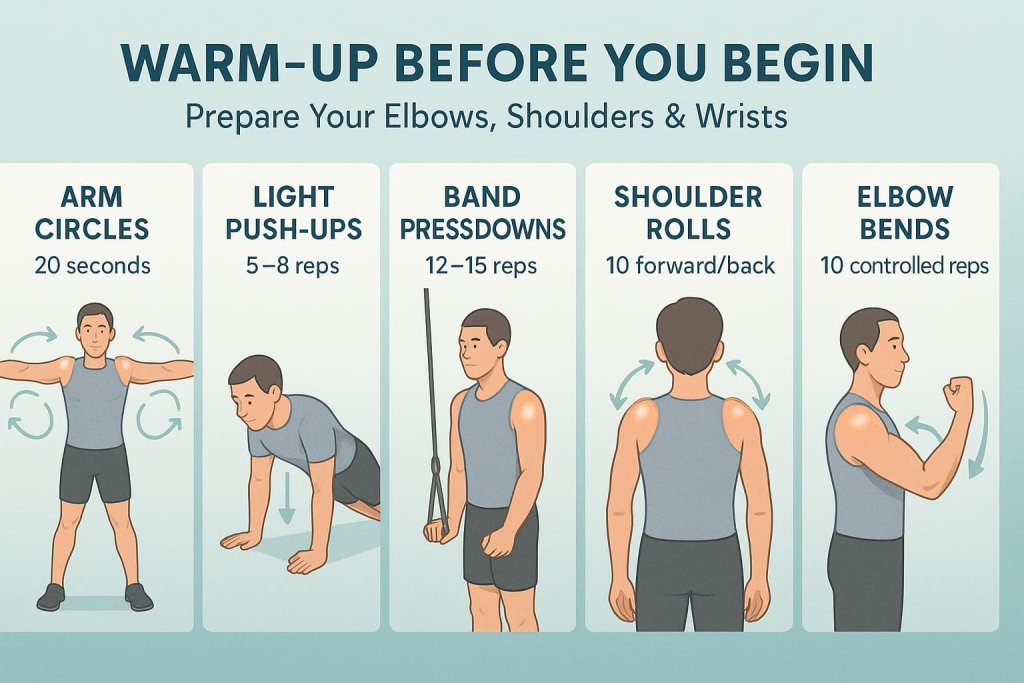If you want bigger, stronger arms, the triceps matter more than the biceps because they make up about two-thirds of total upper-arm size. The best tricep exercises for men focus on elbow extension, controlled loading, and angles that hit all three tricep heads for balanced strength and definition.

This guide explains the 10 best science-supported exercises, how to do them safely, and what men should know about training volume, frequency, and joint protection.
Strengthening your triceps helps with bench press performance, overhead pushing power, and everyday functional strength. Below, you’ll find evidence-backed exercises, simple technique cues, progression options, and links to authoritative resources like ACE Fitness and scientific journals.
Benefits of Tricep Training for Men
Tricep training plays a major role in building arm mass, improving upper-body strength, and enhancing athletic performance.

Key Benefits:
- Increases arm size by developing the long, medial, and lateral heads
- Improves pressing strength (bench press, push-ups, dips)
- Supports shoulder stability
- Enhances aesthetics through better arm shape and definition
- Helps prevent elbow injuries by strengthening surrounding tissues
How Often Should Men Train Triceps? (Science-Based Guide)

Current evidence and expert guidelines suggest:
- 10–20 weekly sets for optimal hypertrophy
- Train 2–3 times per week
- Use a mix of heavy (4–8 reps) and moderate (8–15 reps) ranges
- Keep reps controlled with a 2–3 second eccentric phase
- Avoid locking out aggressively to protect elbows
Warm-Up Before You Begin
A quick warm-up protects your elbows, shoulders, and wrists before tricep training. It increases blood flow, improves mobility, and helps you lift with better control.

Quick Warm-Up (2–3 Minutes):
- Arm circles – 20 seconds
- Light push-ups – 5–8 reps
- Band pressdowns – 12–15 reps
- Shoulder rolls – 10 forward/back
- Elbow bends – 10 controlled reps
Trainer Tip: Warm up lightly and avoid rushing—your joints should feel prepared, not tired.
10 Best Tricep Exercises for Men
Build bigger, stronger arms with these science-backed tricep exercises designed specifically for men. Each movement targets all three tricep heads to maximize size, strength, and definition.
1. Diamond (Triangle) Push-Up
Why It Works:
Diamond push-ups create one of the highest levels of tricep activation among bodyweight exercises. Bringing the hands close together forces the elbows into a tight, vertical path, placing maximum tension on all tricep heads with minimal assistance from the chest.
Muscles Worked:
- Primary: Triceps brachii (long, lateral, medial heads)
- Secondary: Anterior deltoids, chest (minor), core stabilizers
How to Do It:
- Place your hands under your chest with thumbs and index fingers forming a diamond.
- Step back into a strong plank with your body in a straight line.
- Lower your chest toward your hands, keeping elbows tucked.
- Press back up while maintaining tight core alignment.
Trainer Tip:
If your wrists feel strained, rotate hands slightly outward or elevate your hands on a step.
2. Bench or Chair Tricep Dips
Why It Works:
Dips train elbow extension through a longer range of motion compared to most bodyweight exercises. They strongly engage the triceps while also challenging shoulder stabilizers.
Muscles Worked:
- Primary: Triceps brachii
- Secondary: Anterior deltoids, upper chest, forearm stabilizers
How to Do It:
- Sit on a bench and place hands next to your hips.
- Slide forward so your hips are just off the edge.
- Lower your body by bending the elbows to about 90 degrees.
- Push through your palms to rise back up without locking out hard.
Trainer Tip:
Keep your shoulders down and avoid dipping too deep to reduce joint stress.
3. Close-Grip Push-Up
Why It Works:
Moving your hands slightly inside shoulder width increases tricep activation while reducing strain on the shoulders. This is an excellent progression for men who want strength without equipment.
Muscles Worked:
- Primary: Triceps brachii
- Secondary: Chest, anterior deltoids, core
How to Do It:
- Place hands just inside shoulder width.
- Keep elbows tight as you lower your body.
- Push through your palms to return to the starting position.
Trainer Tip:
Squeeze your upper arms against your ribs to maximize tricep tension.
4. Close-Grip Bench Press
Why It Works:
Using a narrower grip reduces chest involvement and significantly increases tricep loading. Research shows that close-grip variations activate triceps more than wider-grip presses.
Muscles Worked:
- Primary: Triceps brachii
- Secondary: Chest, anterior deltoids
How to Do It:
- Set grip at shoulder-width or slightly narrower.
- Lower the bar to mid-chest with elbows close.
- Press upward with control, avoiding excessive elbow flare.
Trainer Tip:
Keep wrists stacked directly over elbows for safer pressing mechanics.
5. Skull Crushers (Lying Triceps Extensions)
Why It Works:
This exercise isolates the triceps more effectively than most pressing movements, especially targeting the long and lateral heads due to the elbow-dominant extension pattern.
Muscles Worked:
- Primary: Triceps brachii (long & lateral heads emphasized)
- Secondary: Forearm stabilizers
How to Do It:
- Lie on a flat bench holding an EZ-bar or dumbbells.
- Lower the weight toward your forehead by bending your elbows.
- Extend your arms until elbows are straight, keeping upper arms fixed.
Trainer Tip:
Angle the bar slightly behind the head to reduce elbow stress and keep tension on triceps.
6. Cable Tricep Pushdown (Rope or Bar)
Why It Works:
Cables provide continuous tension throughout the entire range, helping build muscle while reducing joint strain. This makes pushdowns an ideal option for both beginners and advanced lifters.
Muscles Worked:
- Primary: Triceps brachii
- Secondary: Core stabilizers, forearm muscles
How to Do It:
- Stand tall with elbows tucked to your sides.
- Push the bar or rope downward until arms are fully extended.
- Pause briefly, then return with a slow, controlled movement.
Trainer Tip:
Use a rope attachment to achieve a stronger contraction at the bottom.
7. Overhead Dumbbell or Cable Extension
Why It Works:
Overhead tricep work stretches the long head, which crosses the shoulder joint. This stretch-loaded position increases long-head activation—crucial for building arm size.
Muscles Worked:
- Primary: Triceps brachii (long head emphasized)
- Secondary: Core stabilizers
How to Do It:
- Hold a dumbbell overhead with both hands or grip a cable handle.
- Bend elbows to lower the weight behind your head.
- Extend back up without arching your lower back.
Trainer Tip:
Engage your core and keep ribs down to stay safe and maintain alignment.
8. Tricep Kickback (Dumbbell or Cable)
Why It Works:
Kickbacks rank high in tricep activation when performed with strict form. Keeping the upper arm fixed ensures maximum engagement through peak contraction.
Muscles Worked:
- Primary: Triceps brachii
- Secondary: Posterior deltoids, upper-back stabilizers
How to Do It:
- Bend at the hips with a flat back.
- Keep your upper arm glued to your side.
- Extend the elbow backward and squeeze hard at the top.
- Return slowly with control.
Trainer Tip:
Use lighter weight to maintain perfect form—momentum reduces effectiveness.
9. Parallel Bar Dips (Intermediate–Advanced)
Why It Works:
Dips allow heavy loading through a deep elbow-flexion range, making them one of the best compound tricep mass builders when performed upright.
Muscles Worked:
- Primary: Triceps brachii
- Secondary: Chest (depending on torso angle), shoulders, core
How to Do It:
- Support your body on parallel bars with torso upright.
- Lower yourself until elbows reach about 90 degrees.
- Press back up without shrugging your shoulders.
Trainer Tip:
Keep your body vertical. Leaning forward shifts the movement toward chest.
10. JM Press (Advanced)
Why It Works:
A hybrid of close-grip bench and skull crusher, the JM press overloads the triceps through both pressing and extension mechanics, making it a favorite among strength athletes.
Muscles Worked:
- Primary: Triceps brachii
- Secondary: Chest, anterior deltoids, forearm stabilizers
How to Do It:
- Hold the bar with a close grip.
- Lower it toward your chin, keeping elbows high and forward.
- Extend upward using your triceps, not your chest.
Trainer Tip:
Start very light—this lift places high demands on elbow stability and control.
Training Tips for Bigger Triceps
- Use slower eccentrics (2–3 seconds)
- Prioritize full range of motion
- Combine compounds + isolation
- Avoid excessive flaring of elbows
- Warm up with push-ups, band pressdowns, and shoulder rolls
- Increase load or reps gradually (progressive overload)
Common Mistakes to Avoid
- Locking the elbows aggressively
- Letting elbows flare too far outward
- Using too much weight on extensions
- Rushing through reps
- Not warming up wrists, elbows, and shoulders
- Using ultra-narrow grips that strain wrists
Safety Considerations & Medical Disclaimer
Tricep training is safe when done with proper form. Protect your joints by keeping elbows close, avoiding harsh lockouts, and progressing weight gradually. Stop if you feel sharp pain or numbness.
Key Safety Tips:
- Don’t lock out aggressively
- Keep elbows tight
- Move slowly and with control
- Modify dips or overhead moves if they cause discomfort
Medical Disclaimer:
This content is for informational purposes only and not medical advice. If you have elbow, shoulder, or wrist issues, consult a healthcare professional before starting or changing your exercise routine.
FAQs
1. How many tricep exercises should men do per workout?
2–4 exercises are enough depending on volume and experience level.
2. Are tricep exercises safe for beginners?
Yes—start with pushdowns, diamond push-ups, and dips on a bench.
3. Can I train biceps and triceps on the same day?
Yes—many men prefer “arm day” (biceps + triceps + forearms).
4. How long does it take to grow bigger triceps?
Visible progress typically appears within 4–8 weeks with consistent training.
5. Are dips bad for shoulders?
Not if done upright with elbows tight; avoid deep overstretching.
Men with shoulder pain should seek medical advice before performing dips.
6. Should I lift heavy for triceps?
Use a mix—heavy loads (4–8 reps) for compounds, moderate (8–15 reps) for isolation.
7. What tricep exercise builds the most size?
Close-grip bench press, dips, skull crushers, and rope pushdowns are typically top choices.
Conclusion
Stronger, bigger arms rely heavily on tricep development—not just biceps. The exercises above target all three tricep heads, support better pressing strength, and offer options for beginners to advanced lifters.
Train consistently, progress gradually, and protect your joints by using proper form.
Ready to build stronger arms? Start with 2–3 tricep sessions per week and rotate the 10 exercises listed above for balanced growth.
References
- McCrary JM, et al. (2015). A systematic review of the effects of upper body warm-up on performance and injury. British Journal of Sports Medicine.
A systematic review of the effects of upper body warm-up on performance and injury - American College of Sports Medicine (2009). Position stand: Progression models in resistance training for healthy adults. Med Sci Sports Exerc.
Progression models in resistance training for healthy adults (ACSM Position Stand) - NSCA – National Strength and Conditioning Association. Dynamic Warm-Ups for the Land-Based Athlete.
Dynamic Warm-Ups for the Land-Based Athlete - Faigenbaum AD, et al. (2010). Resistance training among young athletes: Safety, efficacy and injury prevention effects. Sports Health.
Resistance training among young athletes: safety, efficacy and injury prevention - Golshani K, et al. (2017). Upper extremity weightlifting injuries: Diagnosis and management.
Upper extremity weightlifting injuries: diagnosis and management - NHS (UK). How to warm up before exercising.
How to warm up before exercising
